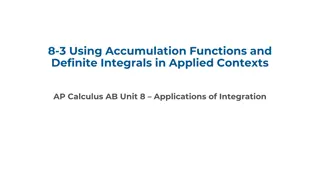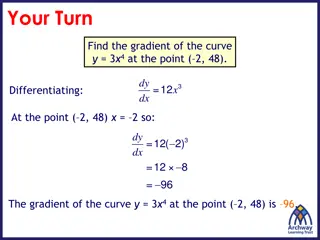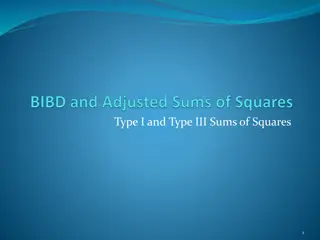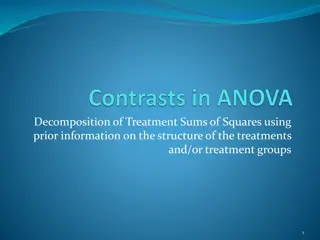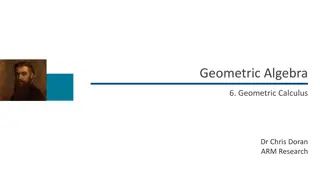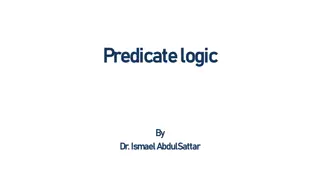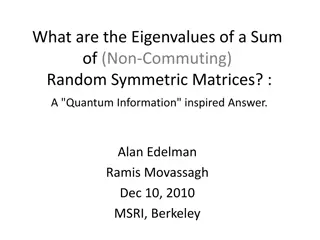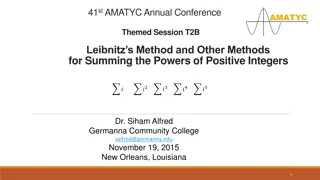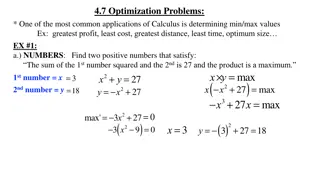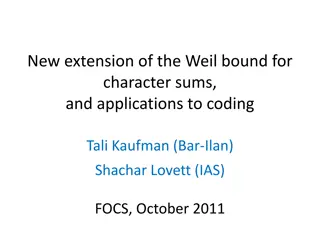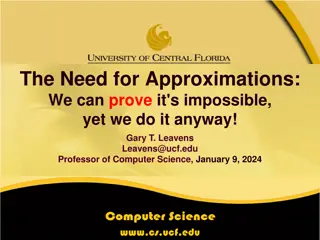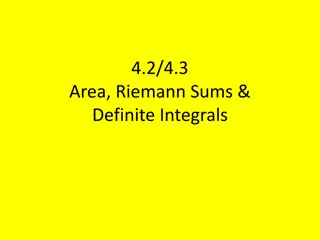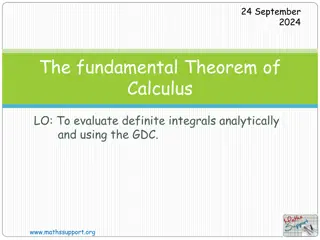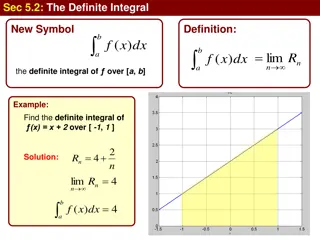Understanding Riemann Sums and Area Approximations in Calculus
Explore the concepts of Riemann sums, different types of approximations like left, right, and midpoint sums, trapezoidal rule, and interpreting area in real-life scenarios with examples. Learn how to apply these methods to approximate irregular areas and calculate distances and average speeds. Dive into the world of calculus with practical applications and visual aids.
Download Presentation

Please find below an Image/Link to download the presentation.
The content on the website is provided AS IS for your information and personal use only. It may not be sold, licensed, or shared on other websites without obtaining consent from the author. Download presentation by click this link. If you encounter any issues during the download, it is possible that the publisher has removed the file from their server.
E N D
Presentation Transcript
mastermathmentor.com presents CALCULUS ON THE WALL Helping students learn and teachers teach 9. Riemann Sums (sample version) Created by: Stu Schwartz Un-narrated Version Edited by: Jake Weinberg Graphics: Apple Grapher: Version 2.3 Math Type: Version 6.7 Intaglio: 2.9.5a Fathom: Version 2.11
Riemann Sums A Riemann sum (named after German mathematician Bernhard Riemann) is an approximation of the region between a function f(x) and the x-axis. The Riemann sum is calculated by dividing the region into rectangles of equal width and then adding the areas of these rectangles. Riemann sums come in three varieties: Left Riemann Sums, Right Riemann Sums, and Midpoint Riemann Sums. The area under the curve is approximated with 4 left Riemann sums. For this function, this will underestimate the true area. The area under the curve is approximated with 4 right Riemann sums. For this function, this will overestimate the true area. The area under the curve is approximated with 4 midpoint Riemann sums. For this function, this will come close to the true area. www.mastermathmentor.com
The Trapezoidal Rule Recall that the area of a trapezoid = base (h1 + h2). h2 h1 base A 1 +1 2 ( ) f 0 ( )+ f 2 ( ) 2 ( ) f 2 ( )+ f 4 ( ) 2 2 A 1 2 ( ) f 0 ( )+2f 2 ( )+ f 4 ( ) A 1+2 5 ( )+17 A 28 2 A 1 21 ( ) f 0 ( )+2f 1 ( )+2f 2 ( )+2f 3 ( )+ f 4 ( ) A 1 2 A 26 1+2 2 ( )+2 5 ( )+2 10 ( )+17 www.mastermathmentor.com
Approximating An Irregular Area A golf green is 60 feet across at its widest point. The green is divided into 6 sections of equal width having measurements in feet as shown below. Use left, right, and midpoint Riemann sums as well as trapezoids to approximate the area of the green. base = 60 =10 6 Left: A 10 4+16+ 32+ 47+ 42+ 38 ( ( )=1,790 ft2 )=1,830 ft2 Right: A 10 16+32+47+42+38+8 Trapezoids: A 10 [ ]=1,810 ft2 4+ 32+64+94+84+76+8 2 OR A 1790+1830 =1,810 ft2 2 ( )= 2,020 ft2 Midpoint: A 20 16+47+38 www.mastermathmentor.com
Interpreting Area When the x-axis is measured in time and the y-axis is measured as a velocity, the Riemann sum will be measured in the product of time and velocity which is distance. Thus area under a curve has an important real-life interpretation. A bicyclist has his speed monitored over a hilly section of a course. The table gives his speed at 5 minute intervals in miles per hour. Use the trapezoidal rule to approximate the distance he travels over 40-minutes and his average speed. min mph 0 10 5 16 10 18 15 9 20 12 5 minutes is a fairly large increment. If you use smaller time increments. You gain accuracy but increase the number of calculations. 25 7 Units should be consistent. Time will be measured in hours. Base = 5 12 Distance 1 2 12 Distance 8.917 miles Average speed distance time 30 14 60=1 35 20 40 12 10+ 32+ 36+18+24+14+28+ 40+12 1 [ ] =8.917 miles 2 3 hours =13.375 mph www.mastermathmentor.com
Purchase the full version - 18 slides Content: Riemann Sums www.mastermathmentor.com Powerpoint slides to help teach in the classroom Only $10.95 for the full presentation of 18 content slides. (download version) You receive: A narrated version (59 megs) An un-narrated version (4 megs) A PDF of the narration used if you want to provide the commentary Note: Downloading the full presentation may require high-speed internet. Or purchase the entire set of MasterMathMentor.com AB Calculus On the Wall Powerpoint presentations - Only $119.95 - sent to you on a 2-gig flash drive. Topics cover: Limits Derivative Definition Motion Related Rates Optimization Antiderivatives Definite Integrals Area/Motion Revisited Inverses/Transcendentals Differentiation Function Analysis Riemann Sums Volume Differential Equations www.mastermathmentor.com




